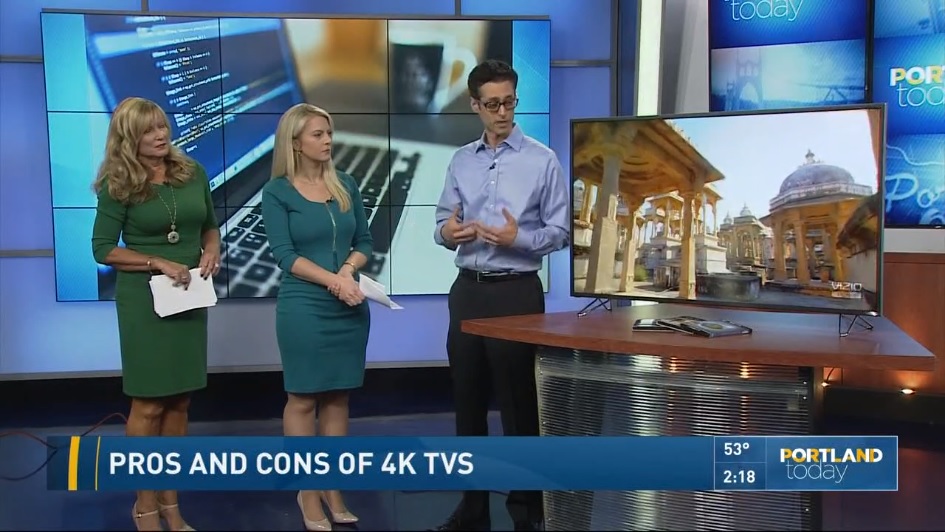Vizio M50-E1 50″ HDR UHD Display Review
Pros
Cons
Rating
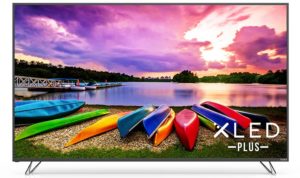
This happens to be our very first “TV” review, but it’s most definitely not our first display review, and in fact we’ve tested a variety of TVs over the past few years; we just haven’t published reviews of them because they become outdated so fast. Thanks to Vizio, however, we got our hands on a brand-new 2017 model before a new one was right around the corner, and we’re going to be putting the M50-E1 through its paces to see whether its promise of delivering 4K resolution, HDR capability, and a broad range of streaming options is as good as it sounds given the $600 asking price. Throughout this test, we’ll be comparing the M50-E1 to a Samsung UN55HU8550 55″ 4K model, which was considered the very best 4K TV when it was released for $2,500 in 2014, as well as LG’s OLED65C6P, which at $4,000 was chosen by many editors as the best TV on the market until its replacement arrived this spring. Tough benchmarks? Perhaps, but if Vizio, which is known for cutting consumers a pretty good deal, can even approach the quality and features of these sets, it’s going to be doing pretty well!
Special thanks to Vizio for providing a free sample of the Vizio M50-E1 for review.
Update: Catch The Tech Buyer’s Guru discussing the ins and outs of the Vizio’s 4K HDR capabilities on NBC/KGW-8’s “Portland Today Show”!
Description and Features

The M50-E1 features a relatively standard design. The panel itself measures 49.5″ diagonally, with bezels that are 1/2″ thick on all sides, but because of the slim strip of black area on the outer margin of the panel, the effective bezel is a bit wider, more like 5/8″. The M50-E1 is 25.6″ tall and 44.5″ wide according to our tape measure, and is a rather chunky 2.9″ thick. The metal loop feet add an additional 2.4″, making the set exactly 28″ tall when assembled on a stand rather than mounted on the wall. Notably, the feet are very wide-set, at 38.5″ end-to-end, meaning you’ll need a stand that’s at least 40″ wide to ensure that the M50-E1 doesn’t slide off the edge when bumped. This is in contrast to a lot of more expensive models that use a center-mounted foot design, which allows the user to set the TV on top of a stand that isn’t nearly as wide as the TV itself. While it could be argued that having a TV overhanging your stand isn’t aesthetically pleasing, it’s always nice to have the option, and unfortunately you really don’t have that with the M50-E1.
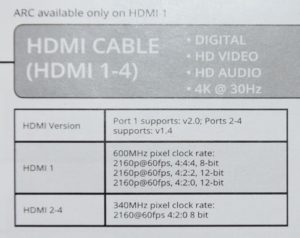
In terms of connections, the M50-E1 is fairly complete, with a notable exception. Along the side of the frame, it has a USB input, component video along with stereo inputs, plus an HDMI port. On the rear, facing downwards (ideal for wall mounting), you have Ethernet, two more stereo jacks (these being for output to a receiver), a digital optical out, and three more HDMI ports. So this is all very good, but the one issue is that there’s only one HDMI 2.0 port (labeled HDMI 1), which is thus the only port capable of accepting true 4K signals. That’s of course the one you’ll need for high dynamic range (HDR) content as well – the M50-E1 is very cutting-edge in that regards, supporting not just HDR10 but the superior Dolby Vision also. As a Vizio representative clarified for us, to enable HDR content even on HDMI port #1, you must go into the VIZIO display’s Input settings to enable the “full UHD color” function, which turns on the 10-bit signal from UHD content and provide full color and dynamic range.
HDMI port #1 happens to also be the audio return channel (ARC) port, used to send audio from the TV to a receiver, as you’d use for media streamed through the TV itself. This becomes a bit of a problem, as you can only get 4K video into the TV through that HDMI #1 port, but you may also want to connect it through the receiver to get audio out. That’s going to cause some issues for anyone without a circa-2016 high-end receiver that can pass UHD HDR video. The vast majority of receivers cannot do this, which means you’ll need to connect a 4K HDR source, like a 4K Blu-Ray player, into HDMI port #1, but can’t get audio out of it to your receiver. We’d much rather see just three HDMI ports and have them all be HDMI 2.0-compliant than have one such port and three HDMI 1.4 ports. We predict a lot of buyers of the M50-E1 won’t realize the limitations the set has until they go to hook up true 4K equipment down the line, like HDMI 2.0-equipped gaming PCs, game consoles, or 4K Blu-Ray players. Remember, this is a TV that retails for $600 – the vast majority of its buyers aren’t going to have $1,000+ AV receivers capable of switching this gear for them now or in the future. Want to watch HDR content from your 4K Blu-Ray player and your shiny new Xbox One X? You’re going to be fumbling with some cables over and over!

In addition to buying a third-party device, there are three ways to get streaming content from the M50-E1: the Vizio “StreamCast Mobile” app for smartphones, the new-for-2017 built-in “SmartCast TV” apps, and Chromecast, which uses third-party apps with built-in support for casting via Google’s Chromecast system. To a certain extent, there’s a lot of overlap between these functions, and in our opinion, if the M50-E1 had a full suite of built-in apps, there just wouldn’t as much need for the SmartCast mobile app. Alas, Vizio’s built-in apps are quite limited, and one of the biggest, Amazon Video, was just recently added (the other big ones included being Netflix, Hulu, Vudu, and Crackle). A few apps that are notably missing are YouTube, Pandora, Spotify, and HBO Now, but these are all available in the mobile app. Basically, users are going to have to do a bit of hunting around if they frequently use various media sources. When we asked a Vizio representative whether YouTube would eventually find its way to the TV’s built-in app list, the response was that “VIZIO will continue to update and expand the SmartCast TV interface. SmartCast Mobile provides access to thousands of Chromecast-enabled apps.” Speaking of Google, we should mention that the M50-E1 even has built-in Google Home Assistant capabilities, meaning it allows you to control it with your voice. We’ll be checking that out on the next page too, but in short, it’s not a killer app yet.
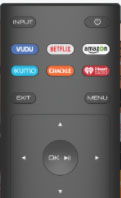
The remote that Vizio shipped with our M50-E1 sample was very basic, and we were informed that consumers will either get a newer remote in the box, or have the chance to upgrade for free to the new “SmartCast TV” remote that adds dedicated buttons for a variety of built-in services like Netflix and YouTube. We can only show you a render of what that remote looks like based on what’s shown on the Vizio website. We think the dedicated buttons will make the M50-E1 even more user-friendly for consumers who are really buying it for its Smart TV features, as opposed to just using it to watch cable or play movie discs and games.
We’ve always wondered how TV manufacturers would handle the constant ebb and flow of content providers. It requires lots of “upkeep” in terms of supporting a variety of apps, which traditional TVs didn’t have… manufacturers could just put them out on the market and sort of forget about them, other than warranty claims. Things are different now, and we don’t doubt that some of the providers included on the remote won’t be around in a few years, and unlike in an app, they can’t be easily “deleted”! Such is life in the high-bandwidth streaming lane!
All right, now we’ll get into what it’s like to use the M50-E1 to consume 4K content.
Performance
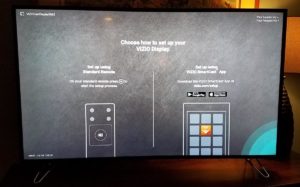
First off comes setup. The M50-E1 takes its “smarts” to heart by allowing you to set it up via a smartphone, which can be quite a bit easier due to the availability of a touchscreen for typing in information. We chose this method, and while it worked quite well for most aspects of setup, the network configuration failed, potentially due to the confusion of having the phone connected to one home network and the TV connected to another. In any event, we were not able to get our sample connected on the first try, despite typing in all the correct network information, and it wasn’t until we returned to the TV the next morning that we found that it resolved its issues and connected itself to our home network. There’s probably just a bit more ironing out that Vizio needs to do to get setup by smartphone working perfectly.
The first thing you may notice about the M50-E1 is that it boots into a live smart screen. This is a huge advantage in a day and age where so many users are getting their content from something other than an antenna or old-style cable box (which, notably, the M50-E1 does not support, as it has no coax input). Too many modern TVs, including our 2014 Samsung 4K model, default to static if you don’t have one or the other attached, and even our 2016 LG OLED reference model defaults to a screensaver. We’d really like to see statistics on how most media is being consumed today, but we’d guess it’s not cable or antennas, especially in the young, savvy, cost-conscious market that Vizio is targeting. Now, one major drawback of Vizio’s approach is that the welcome screen, shown below, takes a lot of time to load. Even in “quickstart” mode, the TV took 13.75 seconds to turn on, and in “eco” mode it took 15.5 seconds. Given how close these two are, we’d just as soon leave it in eco all the time for the energy savings while off. We think the slow startup really stems not from the power-up delay, but from the slow processor that Vizio has built into the M50-E1. Essentially, it’s acting as a mini computer, and like any computer, it needs to “boot up.” Overall, we still like the approach of booting into a welcome screen rather than a blank screen, but it doesn’t come without drawbacks in a lower-cost model like this one.
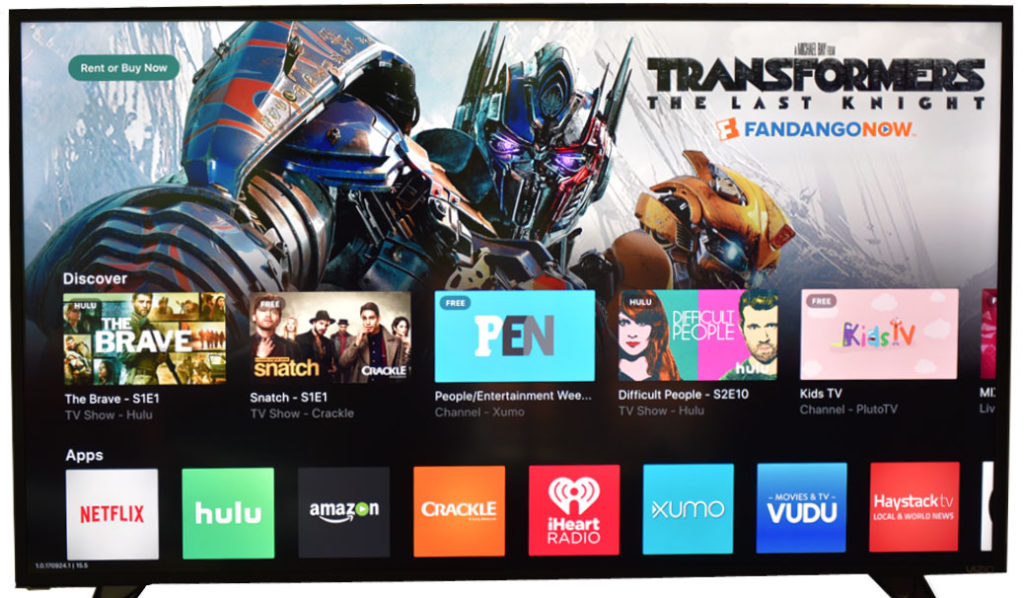
We tested the M50-E1 using a variety of 4K sources, including Amazon Instant Video via the built-in SmartCast TV app, YouTube via the SmartCast Mobile app, as well as 4K discs via our Oppo UDP-203. Overall, we were very impressed given the pricepoint. No, it won’t match an LG OLED when it comes to color and contrast, and it’s not as bright as LEDs from Samsung and Sony that cost twice as much, but it’s very good, certainly good enough to be someone’s first 4K display. In fact, there’s been such great progress among LCD panels in the past few years that the M50-E1 is easily a match for our Samsung HU8550 from 2014, which retailed for $2,500. HDR content, like Planet Earth II and the science-fiction film Arrival (which uses lots of panning shots) looked great, and John Wick 2, which has among the widest dynamic ranges you’ll find in any movie, looked fantastic. Furthermore, we believe Vizio has struck a pretty good compromise in terms of its motion handling in films, avoiding excessive smoothing while still offering decent 3:2 pulldown to avoid excessive judder. If you want the ultimate test of motion handling in films, check out Planet Earth II at the 23-minute mark, a panning shot of iguanas running across a rocky shore with snakes behind them. The motion, contrast, and brightness of this image are a serious test of any display, and the M50-E1 did a fine job, avoid the distracting artifacts that over-processing can cause.

It’s really hard to demonstrate what HDR is without an HDR screen, but this sample from Planet Earth II, which looked great on the Vizio display, gives an indication of what you can expect: extreme contrast, challenging visual depth, and intense colors that just can’t be displayed without the broader range that HDR allows. Again, we’ve seen better on LG’s OLEDs, but they cost about four times as much. Assuming users of this TV won’t be spending more on their AV gear than they do on their display, they’ll be more than satisfied. Alas, we were disappointed to find that watching content tagged as HDR through the built-in Amazon app did not properly display as HDR10 (as indicated by the lack of an HDR10 notification in the “info” panel), and defaulted to standard 4K content. Our guess is that this is a limitation of Vizio’s app, and we hope Vizio can work with Amazon to bring this great source of 4K HDR10 streaming content to consumers. Spike Lee’s “Chi-Raq”, available on the service, is one of our favorite pieces of demo material thanks to its outlandish color palette (and Samuel L. Jackson’s even more outlandish narration), and it’s a shame it can’t be enjoyed to its fullest on the Vizio.
While we wouldn’t judge a display for its audio, we found the built-in speakers on the M50-E1 surprisingly good. It helps that the display isn’t particularly thin, which gives the set the ability to produce a bit more bass then paper-thin models. The only weakness we found was that dialogue could get lost amidst sound effects and music in complex surround soundtracks, which no doubt is a result of trying to do a bit too much with a set of stereo speakers. That being said, the M50-E1 actually provided a pretty good approximation of surround sound, and overall, we don’t think anyone would be disappointed in the audio. Serious audiophiles will of course get a separate AV anyway, but it’s not critical if you’re just building out your system.
One last feature that the M50-E1 has is a tie-in with the Google Home Assistant, allowing for voice control. We think this is very cool in concept, but it’s just too finicky at this point. While we could use the Google Home app (notably not the Vizio app) to connect the M50-E1 and the Home Assistant, voice commands were not properly understood, and even if they had been, only three apps are currently supported according to the Google help page: Netflix, CBS, and CW. So we’re going to pin the blame for this misfire of a feature on Google, not Vizio. It’s really just an extension of the Chromecast functionality, and we’re guessing Vizio has no control over it whatsoever. If it did, we’re sure Vizio would consider partnering with Amazon and its Alexa voice service, which will soon erase any memory of Google Home, from our point of view (and based on our extensive testing).
Conclusion
There’s just no other way to say this: the M50-E1 is a great deal! Given its $600 retail price, it packs in tons of features, including a variety of ways to enjoy streaming content, aided by a user-friendly interface that puts streaming content front and center when the TV is powered on. This is fitting, given that the M50-E1 has no built-in tuner, and cannot accept antenna or standard cable signals. Remember, Vizio is marketing the M50-E1 as a UHD display, not a UHD TV, because in reality, it’s not a television, which may confuse some consumers not familiar with the difference. As long as people go in knowing what they’re getting, that’s just fine with us. But what most impresses us is that the M50-E1 offers full HDR support, including support for Dolby Vision, which is so new and so cutting-edge that very few external 4K devices support it at this time (the $550 Oppo UDP-203 we used for testing was the first such disc player, thanks to a firmware update pushed out mid-summer 2017). In fact there are only a handful of discs on the market that feature Dolby Vision as of our publication date, although the Vudu streaming service offers quite a few options for rent or purchase. For a display that costs as little as it does, the M50-E1 is certainly in fairly elite company.
There are just a couple things we would change about the M50-E1. The startup time is notably slow, the multiple overlapping methods of getting streaming content to the TV provides plenty of options but can be confusing, and the styling and stand design could use a bit of work. Plus we think the Google Home integration is sort of a gimmick. Put another way, the M50-E1 is perhaps a little rough around the edges, but we think that’s reasonable – this model is designed to hit a pricepoint, a very competitive one at that, and shouldn’t be mistaken for a luxury model.
The Vizio M50-E1 was released with an MSRP of $599.99, and is available for a discounted $549 shipped free from B&H Photo Video, as well as various other retailers, as of our publication date. At that price, it certainly gets our highest recommendation.


